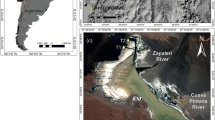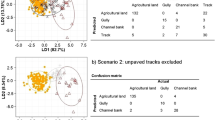Abstract
GEOCHEMICAL reconnaissance by the sampling of stream sediment has indicated patterns of high or above normal molybdenum both in the Republic of Ireland1,2 and in several areas in England and Wales2–4. Anomalous concentrations of molybdenum in the stream bed have usually been correlated with the underlying bedrock geology and the source of the molybdenum traced to black marine shales of varying age. Good correlations have been established between the molybdenum content of the stream sediment and that of the topsoil, though this relationship may be subject locally to variation in secondary environment, soil parent material and sediment geochemistry. Comparison of regional geochemical data with information on disease incidence in livestock has indicated that, in addition to confirming areas in which clinical molybdenum-induced hypocuprosis is already recognized, the method may also delineate areas in which the subclinical problem occurs. Highly significant relationships have been established between drainage molybdenum patterns on one hand and bovine blood copper concentrations on the other in Co. Limerick, Derbyshire and north Staffordshire3,5. In the two latter areas animal trials over the past 2 years have shown an economic response to copper supplementation in herds where clinical symptoms of deficiency are absent.
This is a preview of subscription content, access via your institution
Access options
Subscribe to this journal
Receive 51 print issues and online access
$199.00 per year
only $3.90 per issue
Buy this article
- Purchase on Springer Link
- Instant access to full article PDF
Prices may be subject to local taxes which are calculated during checkout
Similar content being viewed by others
References
Webb, J. S., and Atkinson, W. J., Nature, 208, 1056 (1965).
Webb, J. S., New Sci., 23, 504 (1964).
Webb, J. S., Thornton, I., and Fletcher, K., Nature, 217, 1010 (1968).
Thornton, I., thesis, Univ. London (1968).
Thornton, I., Atkinson, W. J., Webb, J. S., and Poole, D. B. R., Irish J. Agric. Res., 5, 280 (1966).
Clark, A., J. Bath and West England Soc., 3, 52 (1855).
Gimingham, C. T., J. Board Agric., 17, 529 (1910).
Ferguson, W. S., and Lewis, A. H., J. Min. Agric., 49, 82 (1942).
Ferguson, W. S., Lewis, A. H., and Watson, S. J., J. Agric. Sci., 33, 44 (1943).
Ferguson, W. S., Proc. Nutrit. Soc., 1, 215 (1944).
Lewis, A. H., J. Agric. Sci., 33, 52 (1943).
Le Riche, H. H., J. Soil Sci., 10, 133 (1959).
Le Riche, H. H., Geochim. Cosmochim. Acta, 16, 101 (1959).
Author information
Authors and Affiliations
Rights and permissions
About this article
Cite this article
THORNTON, I., MOON, R. & WEBB, J. Geochemical Reconnaissance of the Lower Lias. Nature 221, 457–459 (1969). https://doi.org/10.1038/221457a0
Received:
Issue Date:
DOI: https://doi.org/10.1038/221457a0
This article is cited by
-
Some observations on heavy metal concentrations in soils of the Mendip region of north Somerset
Environmental Geochemistry and Health (1991)
-
Heavy metals in soils in north Somerset, England, with special reference to contamination from base metal mining in the Mendips
Environmental Geochemistry and Health (1990)
-
Data handling and pattern recognition for metal contaminated soils
Environmental Geochemistry and Health (1989)
-
The effect of soil additives on the uptake of molybdenum and selenium from soils from different environments
Plant and Soil (1972)
Comments
By submitting a comment you agree to abide by our Terms and Community Guidelines. If you find something abusive or that does not comply with our terms or guidelines please flag it as inappropriate.



